Forging Ahead: Unfinished Business
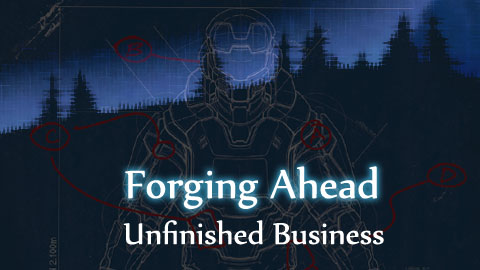
So for the next piece, I’m going to zoom in a bit and go over some of the finer details and thought processes I didn’t touch on this time around, and how they played out.
That was how the last Forging Ahead entry concluded back on March 14…of last year. So I should probably kick off this long belated entry with a bit of an explanation.
Since that last cliffhanger entry, my Forging cap has been hung up. Not because of a lack of desire to create maps in Reach, but because of the roadblocks I encountered along the way to trying to make them.
For those who may have forgotten where this left off (in other words, everyone), I had just gotten through a major rebuild of a custom map called Sandybridge, prompted by a play test that did not go according to plan. That test showed that the map funneled players into a major bottleneck, the bridge, without either enough outlets; everyone poured into the center and the rest of the map got ignored. I put a lot of thought into how to solve the problem, ultimately reworking the overall flow of the map and updating most of the geometry. In the end, it looked like this.
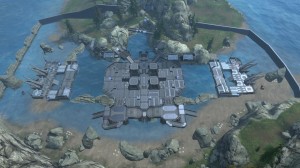
Having updated nearly every part of the map other than the bases, I triumphantly brought the map to the next customs game night for testing. As it turns out, the map played dramatically better. The bottleneck in the center was resolved, and the beach and island sections of the map got a lot more play. Players were able to quickly move across the major sections of the map, spreading the sole choke point out into several and creating some interesting mid to long range shootouts.
It played almost as well as I had hoped. The game did highlight that the bases need to be rethought, as it was too simple to march up the ramps to the base, grab the flag and march off with it to a waiting Mongoose. I had anticipated this problem, given that the bases were built for the earlier version of the map, and was planning to address them next.
So why did Forging Ahead come to a screeching halt after that play test? Because the same game also revealed crippling performance issues with 16 players on the map; from most angles, frame rates dropped dramatically, with firefights on the titular bridge were especially bad. Scoping from one base looking down center brought it down to single digits. It was simply borderline unplayable. After all the planning, thought and effort I had put into the map, I was crushed to find my baby was broken beyond all hope of repair. No tweaking around the edges was going to work here. The problem was fundamental to the concept: the game engine could not handle a map of this design.
I was so crushed that I put the map on the shelf and never revisited it, and was so upset by the failure that I could never get myself to write about it; I wanted to just forget the whole ordeal. But time heals all wounds (well, most of them), and given that 343 Industries has now revealed Forge for Halo 4, it felt like I had a narrow window to put my Reach Forging adventures to bed once and for all.
After the Sandybridge failure, I took a long hiatus from Forging, but after a few months a thought began tickling the back of my mind. The thought was, remember that Crossroads map? The first map you built, for the Forge contest? It got so close to being really good, but never quite got there. Don’t you want to finish it up properly?
After six months of nagging, the thoughts got louder and louder until I found myself back in Forge, brainstorming. Ultimately, I did rework the map dramatically, but didn’t write about doing so for reasons I’ll touch on a the end. Most observers can probably figure it out by now.
Since so much time has passed, I’ll just briefly highlight the design problems I left hanging, and the solutions I arrived at. This was Crossroads as I had left it:
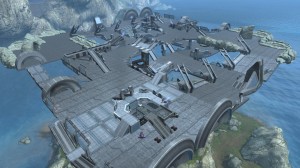
A symmetric map BTB with undulating, folding roadways and man cannon shenanigans, Crossroads had three fundamental problems. First, there was some fat on the map in the form of underutilized play space. I needed to find a way to either trim them without breaking the map, or updated them so player could more effectively utilize the space.
Second, the flat nature of the map made cross mapping with the DMR excessive, as players could be pinged from too many angles and from too far away. This particularly hurt base assaults and escapes with a flag. I need to find ways to break up sight lines while not cluttering up the overall flow of the map, for infantry or vehicles.
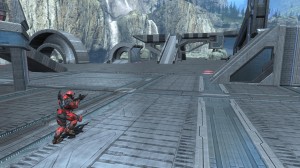
Finally, infantry movement was still not optimal. Crossroads is a very large map, and even with the maximum number of man cannons and gravity lifts employed to help players on foot zig zag through it, people were getting stranded in places they didn’t want to be. They needed to be able to move between levels and even sides of the map with greater ease.
With these objectives in mind, I dove in. Because I was close to the budget limit, I tackled the first issue first in order to free up funds for other map modifications.
The greatest expanse of unused territory lay below the bases. I had resisted removing it in all previous iterations of the map because it was critical to the base design, allowing a way to enter from below. Removing the space beneath the base would necessitate a full base redesign.
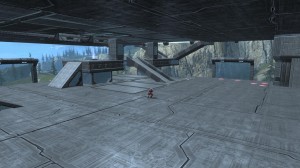
I think I kept this area around so long because of how flat the rest of the map is. Players can tag attackers from very long range, so it was important to allow a stealthier way to approach the base. The fact is, it was just easier to leave it there as an outlet than it was to address the sight line problem. In deciding to remove it, I knew I’d need to address the base approach issues to compensate. It also meant I’d need to rebuilt the bases, since the lower access way was central to their design. Just patching it up wouldn’t work.
In the end I simply deleted most of the far corner, and left just enough so that Warthogs could careen around the corner without worrying about flying off the sides. Infantry could disembark and take a folding ramp up to the side of the base above, but the space was otherwise scorched.
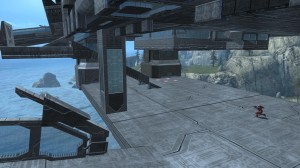
With some budget freed up to work with, I set about finding a solution to the long sight lines. The biggest culprit was down the flat sides of the map, below the man cannon towers.
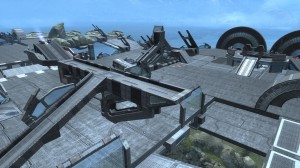
I played with a few basic ideas, which mostly consisted of plopping objects down for cover along the way. But that didn’t leave enough room for vehicles to navigate well and more often than not just cluttered things up. I abandoned it in favor of a more dramatic – and time consuming – solution: altering surface of the map itself.I built a hill into the longest expanse on the map, cutting the sight line down by over half.
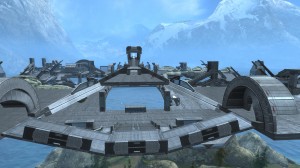
This had a number of immediate benefits, the biggest of which is that it let players approach the base from one side of the map without taking fire. Assaults on the base, not to mention escapes, would be much more viable. It also made the map even more fun to drive around on, though it took some fine tuning to ensure leaping Warthogs would not tip on the way down, or smack the tower as it leaped over the top.
The incline also helped define the space I had left to place the new bases, and so I set about reimagining something that would be interesting to assault while leaving room for vehicles to circle. They need to provide multiple points of entry, supply cover while not being a fortress, allow room for vehicles around them yet not be too cramped, and provide safe areas for player respawns. Yeah. It took a while.
I went through a large number of iterations before settling on something functional, if (typically) utilitarian. A wide but defensible front entrance faced the new incline, providing shelter for those spawning inside.
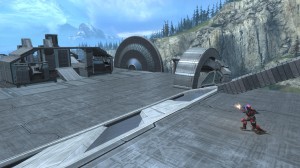
Resembling a sort of reversed Valhalla base, they feature a wide if defensible entry and an elevated, exposed platform in the rear for flags and bomb arming. The elevated section had the benefit of creating a larger base, while still allowing vehicles to circle from below.
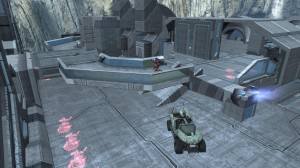
Working around the perimeter of the map, I turned next to the corners. They had been envisioned as a respawn location and area for cover and quick escapes on the Mongoose, and served their purpose. But they were also one of the more barren areas of the map, with little geometry to make dynamic shootouts.
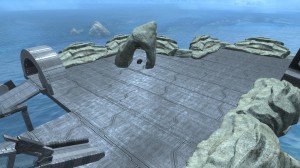
To help break up the flat expanse, I added a rock garden (at the suggestion of a fellow Forger). This left enough room for vehicles to snake between, while allowing infantry ample cover from one another. I had enough budget left to replace the simple archway with a building.
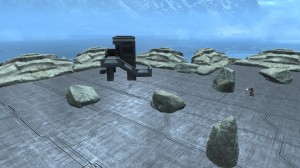
The removal of the gravity lifts below the bases meant I had a pair of objects from the man cannon/teleporter/grav lift category to play with, and given the issues with players getting stranded on corners of the map, put them to use alleviating the problem.
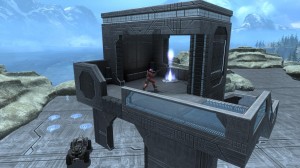
Players had the ability to get from the base to the center of the map quickly, and from the span across from the bases near center back. But the furthest distances apart were these corners. Allowing players to move between them would enable infantry to shift the direction of their approach, whether assaulting a base, cutting off an escaping vehicle on the other side of the map, or fleeing with a flag. It would hopefully mean players no longer felt stranded so far from where they wanted to be.
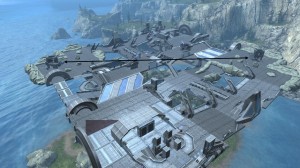
Keeping with the theme of improving infantry movement, I added stone archways to provide them another way between levels, in the center of ramp leading to the lower level. I left the tip of the, um, rock jutting up so that vehicles could not vault up it.
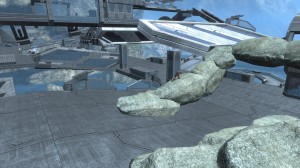
Also at the suggestion of a friend, I addressed how open the roadways were. The sheer width of the large wall pieces meant if players got caught by a patrolling Warthog, they were as good as dead.
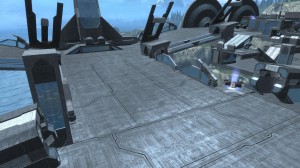
I added “lane dividers” to this area, so were a player is caught out on them by a Warthog, they have a chance to get to the others side for a moment of safety. It helped make the lower area less of a no mans land by adding cover along the far side of the walkway as an added bonus.
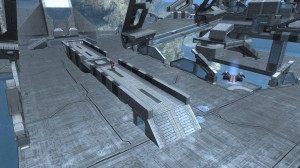
These were the big ticket updates, though I worked in a dozen or more small refinements. With all updates in place, Crossroads 3.0 was ready for playtesting.
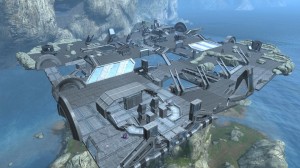
I had once again exhaused the full budget, but this time I had finally addressed all of the issues that had mired the map previously and been haunting for a year and a half. Unused space was removed, sight lines were shortened, and player navigation options were expanded. The only thing left was to play test it. Now, to play test it.
Presenting it to the customs crew, we selected CTF to put some pressure on the bases and see how well balanced they were, both in their design and given the new sight lines. The good news was, this new version of Crossroads was far and away the best. Bases were penetrable, but not too vulnerable. Average engagement distances were much shorter, and more interesting as a result. Fewer players got stranded in flat expanses. With less territory overall, the map felt tighter and combat was more frequent. I came away from the test satisfied with the design – at long last.
I also came away cursing Forge, and never used it again.
The reason was simple enough: Crossroads had the same issue as Sandybridge: when played with the preferred player count (we tested with 14 players), the map suffered crippling frame rate issues at multiple locations. Any time more than one vehicle was in play in a given area, or a lot of action was concentrated, performance took a huge dive and impacted the quality of the game. And as was the case with Sandybridge, the problem was fundamental to the design of the map. No tweaks were going to save it.
It was the last straw, and I abandoned my Forging efforts thereafter. I didn’t see any point in continuing to build maps that fit within the constraints of the tool set, yet were still not functional play spaces. While not perfect, I’m proud of Crossroads, and learned a great deal through the process of designing, testing, iterating and writing about it. It’s available here in file share here, warts and all.
I began this series by exploring the scale of maps that could be created in Forge, marveling at the possibilities. It is concluding – for now – with the realization that the sense of possibility was an illusion. In expanding the scale of our Forging space and options with Reach, Bungie created a more flexible and robust tool to create custom maps than they had with Halo 3’s Sandbox, and many excellent community creations have been built from it. But in so doing, they also created a tool that could break its own creations.
By not setting object and budget caps within the engine performance limitations, Bungie added a significant complication to the process of creating playable maps in Reach. Without a way to evaluate how well the engine would perform on a given map, designing maps in Reach’s Forge is a shot in the dark; designers need not only operate within the limitations of categories object limits and the overall budget, but engage in extensive engine performance testing as well. And so the possibilities that seemed so enticing when Reach first released has been proven an illusion; creator must scale their visions down well below the visible limitations.
Some of the blame can doubtless rest with Forge World itself, an overly detailed enormous used canvas. A map so large and detailed doubtless eats into the engine resources and impacts the options players have available when crafting their own play spaces. While we’ve seen very little of Halo 4’s take on Forge, the only demo we’ve seen so far featured a similarly large, detailed environment – and an even larger object budget. Let’s hope the addition of dynamic shadows to the mix does not mean Halo 4’s Forge will have the same, unknowable limitations.
For Forge to really succeed in Halo 4, 343 needs to ensure that Forge users have the information they need to create playable maps within the confines of the tool they create. That means either providing us a way to evaluate engine performance as we craft play spaces, or setting the object limitations low enough that frame rate issues do not appear. The question is whether 343 has created a Forge that liberates Halo cartographers, enabling our creations to match our imaginations, rather than set us up for disappointments.
When Halo 4 does launch, this series will seek to find the answer.

I’m hoping for more colleseum wall peices. And more peices in general. There always is just too few.
I wonder if there could be some way to transfer forge maps over to halo 4? Hear me out, I know this sounds riduculous. It obviously wouldn’t be into forge world, as that wouldn’t be in the game, more like transfer the peices over, in their current postion, and then place them, and boom! ur old map is back.
That would be cool but it’s unlikely.
Halo 4 uses many of the same building blocks as Reach’s Forge but I think they want everyone to start over again with Halo 4 – even though technically, it might be possible.
that seems like a bad idea, the whole starting over again thing. Symbolicly it sounds cool, but in terms of the real world it just means spending unecesarry hours building something that already has been (built). It’s like how they took away the AI modifying skulls in CE:AE.
Ok just thought of one more point. Are you familiar with how everyone hates the third gen. of pokemon? (not taking a stance, but most people do think it was bad) Well, a generally agreed on reason for it’s flop was that you couldn’t transfer pokemon from generations I or II. This meant that your badass missingno or mewtwo was lost to you forever. While this is clearly not as big as that, it is the same sort of problem. Ok, I’m done. Any longer and I will end up ranting.